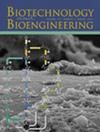结合亲和层析法纯化腺病毒的平台工艺
IF 3.5
2区 生物学
Q2 BIOTECHNOLOGY & APPLIED MICROBIOLOGY
引用次数: 0
摘要
腺病毒载体(AdV)在癌症治疗和疫苗开发中日益突出,提出了对现代AdV制造平台的需求。目前通过离子交换色谱法纯化AdV确实难以达到采用亲和技术的产品收率和纯度。为了解决这些挑战,本研究提出了第一个基于亲和的过程,该过程通过两个色谱步骤提供高产品收率和清除宿主细胞蛋白质和DNA (HCPs和hcDNA)。亲和捕获利用以AdV六邻体蛋白(AEFFIWNA和TNDGPDYSSPLTGSG)为目标的肽配体功能化的树脂,在温和的洗脱条件下(pH 8.0时~50%)提供高容量(>; 5·1010 vp/mL树脂)和产率。采用不同基质(聚甲基丙烯酸甲酯和琼脂糖)制备的肽功能化吸附剂进行了初步测试,以比较其纯化性能。选择AEFFIWNA-SulfoLink树脂是因为其细胞转导adv的产率(~50%)和HCPs和hcDNA的去除率(144倍和56倍)。同样,TNDGPDYSSPLTGSG-Toyopearl树脂的收率为50%,杂质减少了50倍。通过优化洗涤步骤,去除游离六元蛋白和额外的HCPs,进一步提高了产品纯度。所有肽功能化树脂在pH ~2.0条件下再生后10个循环均保持其纯化性能。纯化过程包括澄清,使用AEFFIWNA-SulfoLink树脂在结合-洗脱模式下的亲和捕获,以及使用混合模式树脂在流动模式下的抛光。优化后的工艺可使细胞感染单位(IFU)产率达到50%,产物滴度达到107 IFU/mL,残留HCP和hcDNA水平(分别为8.76 ng/mL和44 ng/剂量)达到临床要求。本文章由计算机程序翻译,如有差异,请以英文原文为准。

Integrating Affinity Chromatography in the Platform Process for Adenovirus Purification
Adenoviral vectors (AdVs) are gaining prominence in cancer therapy and vaccine development, posing the need for a modern AdV manufacturing platform. Current AdV purification by ion-exchange chromatography indeed struggles to achieve the product's yield and purity of processes that employ affinity technologies. Addressing these challenges, this study presents the first affinity-based process that delivers high product yield and clearance of host cell proteins and DNA (HCPs and hcDNA) in two chromatography steps. The affinity capture utilizes resins functionalized with peptide ligands that target AdV hexon proteins (AEFFIWNA and TNDGPDYSSPLTGSG), and provide high capacity (> 5·1010 vp/mL of resin) and yield under mild elution conditions (~50% at pH 8.0). Peptide-functionalized adsorbents prepared using different matrices (polymethylmethacrylate vs. agarose) were initially tested to compare the purification performance. AEFFIWNA-SulfoLink resin was selected for its yield of cell-transducing AdVs (~50%) and removal of HCPs and hcDNA (144-fold and 56-fold). Similarly, TNDGPDYSSPLTGSG-Toyopearl resin afforded ~50% yield and > 50-fold reduction of impurities. Additional gains in product purity were achieved by optimizing the washing step, which removed free hexon proteins and additional HCPs. All peptide-functionalized resins maintained their purification performance for 10 cycles upon regeneration at pH ~2.0. The purification process was assembled to include clarification, affinity capture in bind-and-elute mode using AEFFIWNA-SulfoLink resin, and polishing in flow-through mode using mixed-mode resins. The optimized process provided a yield ~50% of cell-infecting units (IFU) and a product titer ~107 IFU/mL, along with residual HCP and hcDNA levels (8.76 ng/mL and 44 ng per dose, respectively) that meet clinical requirements.
求助全文
通过发布文献求助,成功后即可免费获取论文全文。
去求助
来源期刊

Biotechnology and Bioengineering
工程技术-生物工程与应用微生物
CiteScore
7.90
自引率
5.30%
发文量
280
审稿时长
2.1 months
期刊介绍:
Biotechnology & Bioengineering publishes Perspectives, Articles, Reviews, Mini-Reviews, and Communications to the Editor that embrace all aspects of biotechnology. These include:
-Enzyme systems and their applications, including enzyme reactors, purification, and applied aspects of protein engineering
-Animal-cell biotechnology, including media development
-Applied aspects of cellular physiology, metabolism, and energetics
-Biocatalysis and applied enzymology, including enzyme reactors, protein engineering, and nanobiotechnology
-Biothermodynamics
-Biofuels, including biomass and renewable resource engineering
-Biomaterials, including delivery systems and materials for tissue engineering
-Bioprocess engineering, including kinetics and modeling of biological systems, transport phenomena in bioreactors, bioreactor design, monitoring, and control
-Biosensors and instrumentation
-Computational and systems biology, including bioinformatics and genomic/proteomic studies
-Environmental biotechnology, including biofilms, algal systems, and bioremediation
-Metabolic and cellular engineering
-Plant-cell biotechnology
-Spectroscopic and other analytical techniques for biotechnological applications
-Synthetic biology
-Tissue engineering, stem-cell bioengineering, regenerative medicine, gene therapy and delivery systems
The editors will consider papers for publication based on novelty, their immediate or future impact on biotechnological processes, and their contribution to the advancement of biochemical engineering science. Submission of papers dealing with routine aspects of bioprocessing, description of established equipment, and routine applications of established methodologies (e.g., control strategies, modeling, experimental methods) is discouraged. Theoretical papers will be judged based on the novelty of the approach and their potential impact, or on their novel capability to predict and elucidate experimental observations.
 求助内容:
求助内容: 应助结果提醒方式:
应助结果提醒方式:


